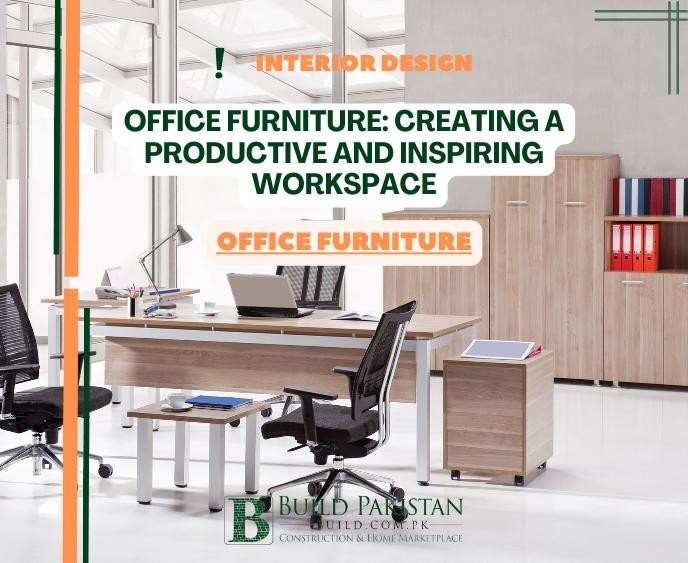Office Furniture: Creating a Productive and Inspiring Workspace

Introduction:
The office environment has a significant impact on employee
productivity, creativity, and overall well-being. One crucial aspect of
creating an optimal work setting is the choice of office furniture.
Well-designed and functional office furniture not only provides comfort and
support but also contributes to a professional and inspiring atmosphere. In
this blog, we will explore the importance of office furniture, different types
of furniture pieces, their benefits, and key factors to consider when selecting
the right office furniture for your workspace.

Importance of Office Furniture
The selection of office furniture goes beyond aesthetics. It
plays a vital role in shaping the work environment and influencing employee
performance. Here are some key reasons why office furniture is important:
Comfort and Ergonomics:
Ergonomically designed furniture
promotes proper posture, reduces the risk of musculoskeletal disorders, and
enhances employee comfort, resulting in improved productivity and well-being.
Functionality and Efficiency:
Office furniture should
facilitate efficient work processes by providing ample workspace, storage
solutions, and organizational features.
Aesthetics and Professionalism:
Well-designed office
furniture creates a positive first impression on clients, visitors, and
employees, reflecting the professionalism and brand image of the organization.
Collaboration and Communication:
Furniture arrangements
can be strategically planned to encourage collaboration, teamwork, and
effective communication among employees.

Types of Office Furniture
Office Desks:
Desks are the centerpiece of any office.
They come in various shapes, sizes, and materials, such as executive desks,
computer desks, standing desks, and modular workstations.
Office Chairs:
Ergonomic chairs with adjustable features,
lumbar support, and proper cushioning are essential for promoting good posture
and reducing the risk of discomfort or injury.
Storage Solutions:
Cabinets, filing systems, shelves, and
bookcases help keep the office organized, ensuring easy access to documents and
supplies.
Meeting Furniture:
Conference tables,
chairs, and presentation boards are necessary for hosting meetings,
brainstorming sessions, and client presentations.
Reception Furniture:
Reception desks, seating, and
waiting area furniture create a welcoming and professional first impression for
visitors.
Breakroom Furniture:
Comfortable seating,
tables, and recreational furniture contribute to employee well-being and
provide spaces for relaxation and informal interactions.

Benefits of Quality Office Furniture
Investing in high-quality office furniture brings several
benefits, including:
Improved Productivity:
Comfortable and ergonomic furniture
reduces physical discomfort, fatigue, and distractions, allowing employees to
focus on their tasks and enhance productivity.
Health and Well-being:
Ergonomic furniture promotes good
posture, reduces the risk of musculoskeletal disorders, and supports overall employee
health and well-being.
Employee Satisfaction:
Providing comfortable and
aesthetically pleasing furniture creates a positive work environment, boosting
employee morale, satisfaction, and retention.
Professional Image:
Well-designed and coordinated
furniture creates a professional and polished look, reinforcing the brand image
and impressing clients and visitors.
Longevity and Durability:
Investing in durable office
furniture ensures longevity, reducing the need for frequent replacements and saving
costs in the long run.
Factors to Consider When Choosing Office Furniture
Comfort and Ergonomics:
Prioritize furniture that promotes
proper posture, adjustable features, and adequate support to ensure employee
comfort and well-being.
Space Considerations:
Assess the available office space
and plan furniture layout accordingly to optimize functionality and traffic
flow.
Style and Aesthetics:
Choose furniture that aligns with
your company's branding, culture, and desired aesthetic, creating a cohesive
and visually appealing workspace.
Quality and Durability:
Look for furniture made from
high-quality materials and with sturdy construction to ensure longevity and
durability.
Budget Considerations:
Determine your budget and strike a
balance between quality and affordability, considering long-term value and
return on investment.
Sustainability:
Opt for eco-friendly and sustainable
furniture options that promote environmental responsibility.
Conclusion:
Office furniture plays a crucial role in creating a
productive, comfortable, and inspiring work environment. By considering the
importance of comfort, functionality, aesthetics, and employee well-being, you
can make informed choices when selecting office furniture for your workspace.
Investing in high-quality furniture will not only enhance employee productivity
and satisfaction but also contribute to a professional and inviting atmosphere
that aligns with your brand image. So, make your office a place where both
productivity and creativity thrive with well-designed and thoughtfully selected
office furniture.









